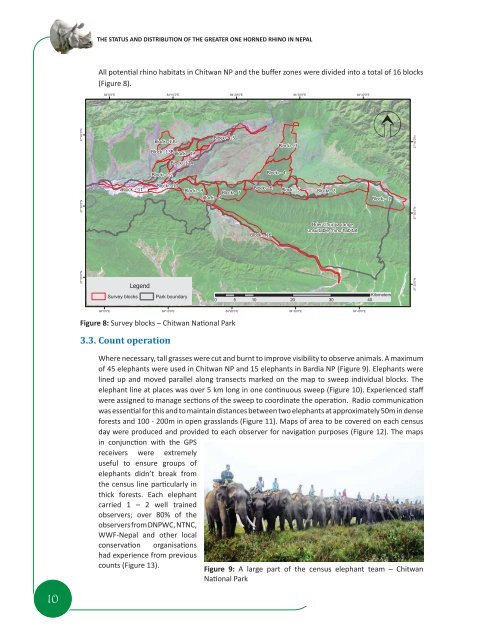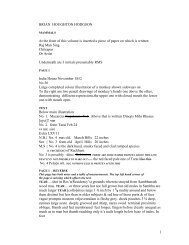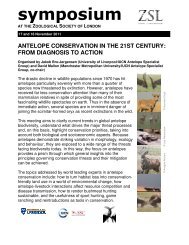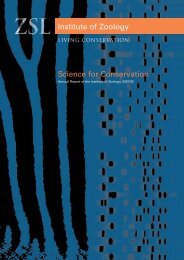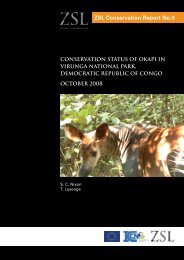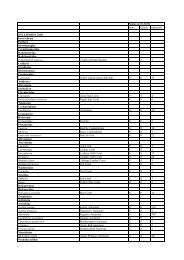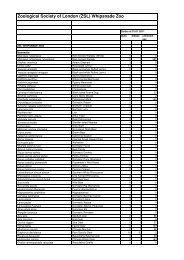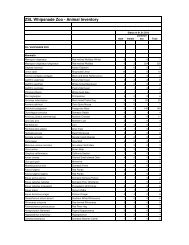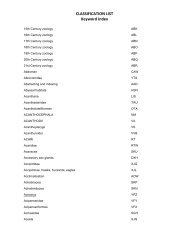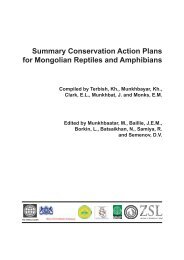the status and distribution of the greater one-horned rhino in nepal
the status and distribution of the greater one-horned rhino in nepal
the status and distribution of the greater one-horned rhino in nepal
You also want an ePaper? Increase the reach of your titles
YUMPU automatically turns print PDFs into web optimized ePapers that Google loves.
10<br />
THE STATUS AND DISTRIBUTION OF THE GREATER ONE HORNED RHINO IN NEPAL<br />
All potenti al <strong>rh<strong>in</strong>o</strong> habitats <strong>in</strong> Chitwan NP <strong>and</strong> <strong>the</strong> buff er z<strong>one</strong>s were divided <strong>in</strong>to a total <strong>of</strong> 16 blocks<br />
(Figure 8).<br />
Figure 8: Survey blocks – Chitwan Nati onal Park<br />
3.3. Count operation<br />
Where necessary, tall grasses were cut <strong>and</strong> burnt to improve visibility to observe animals. A maximum<br />
<strong>of</strong> 45 elephants were used <strong>in</strong> Chitwan NP <strong>and</strong> 15 elephants <strong>in</strong> Bardia NP (Figure 9). Elephants were<br />
l<strong>in</strong>ed up <strong>and</strong> moved parallel along transects marked on <strong>the</strong> map to sweep <strong>in</strong>dividual blocks. The<br />
elephant l<strong>in</strong>e at places was over 5 km long <strong>in</strong> <strong>one</strong> conti nuous sweep (Figure 10). Experienced staff<br />
were assigned to manage secti ons <strong>of</strong> <strong>the</strong> sweep to coord<strong>in</strong>ate <strong>the</strong> operati on. Radio communicati on<br />
was essenti al for this <strong>and</strong> to ma<strong>in</strong>ta<strong>in</strong> distances between two elephants at approximately 50m <strong>in</strong> dense<br />
forests <strong>and</strong> 100 - 200m <strong>in</strong> open grassl<strong>and</strong>s (Figure 11). Maps <strong>of</strong> area to be covered on each census<br />
day were produced <strong>and</strong> provided to each observer for navigati on purposes (Figure 12). The maps<br />
<strong>in</strong> conjuncti on with <strong>the</strong> GPS<br />
receivers were extremely<br />
useful to ensure groups <strong>of</strong><br />
elephants didn’t break from<br />
<strong>the</strong> census l<strong>in</strong>e parti cularly <strong>in</strong><br />
thick forests. Each elephant<br />
carried 1 – 2 well tra<strong>in</strong>ed<br />
observers; over 80% <strong>of</strong> <strong>the</strong><br />
observers from DNPWC, NTNC,<br />
WWF-Nepal <strong>and</strong> o<strong>the</strong>r local<br />
conservati on organisati ons<br />
had experience from previous<br />
counts (Figure 13).<br />
Figure 9: A large part <strong>of</strong> <strong>the</strong> census elephant team – Chitwan<br />
Nati onal Park


